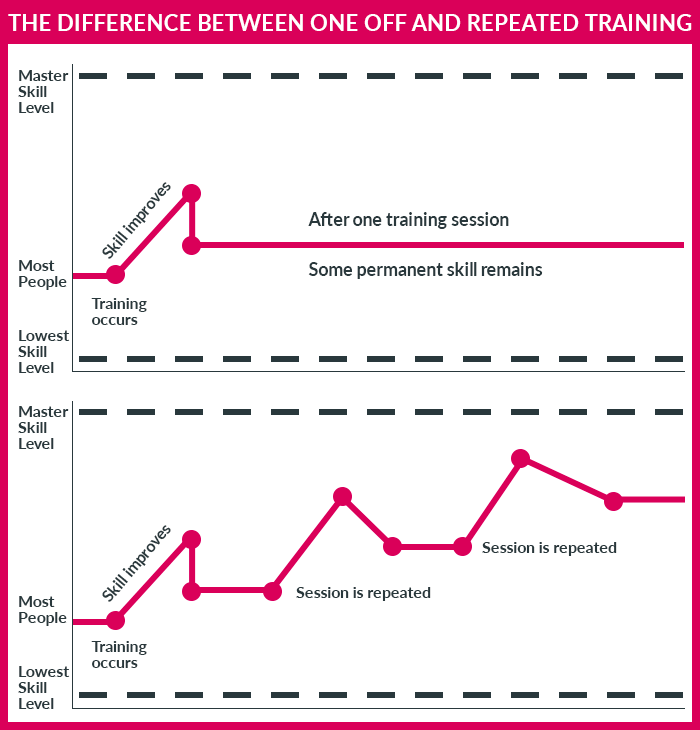Systemisation equals scalability.
If you want to grow and scale your business, building robust systems for every aspect of your business is essential to success.
As business leaders we know this. It’s a common message in many business books. What is less common is looking at why systems commonly fail.
In this post we’re going to explore the 6 reasons why systems regularly fail in SME business. If you understand these reasons, it’s much easier to avoid them.
As well as exploring the reasons why systems fail, we’re also going to look at some tactics you can put in place to make sure your systems are successful.
Let’s get stuck in.
Why systems fail reason 1: Pulling out too early
Getting a process systemised takes commitment.
It is like learning anything new.
You get started. Everything is a bit difficult and feel awkward, but you’re encouraged by the small steps of progress you’re making. You’re also excited about the possibilities and this keeps you motivated.
Then you hit the period where everything seems to be more difficult than it should be. You’re learning and refining, but you’re frustrated that you aren’t getting the results you desire. This is the point where lots of people give up.
If you don't give up, things will then start to click into place. The practice you’ve put in pays off and you begin to see the results that you had in mind when you started.
You’ll now need a new level of motivation to continue learning and taking things forward. If you get complacent, you’ll either stagnate or move onto the next adventure. To really master your new skill, you’ll need to dedicate time and effort to continue your journey.
Avoid pulling out early by expecting frustration and complacency
Understand that with every new system, you or your team are highly likely to hit the frustration period and risk giving up.
Even when you’ve successfully navigated the initial frustration period, remember that you need to continually keep on top of complacency kicking in.
Map these out when you are planning your new system. Understand how you will identify the signs and manage the system through, so that you don’t caught in the trap of pulling out too early.
We see this issue crop up time and time again, it’s often hidden behind something else. Lack of time, lack of money or lack of results. See it for what it really is and you’ll be able to break through to keep on top of your systems
Why systems fail reason 2: Getting distracted
Probably the most common reason that systemisation efforts fail in SMEs is getting distracted.
There’s always a growing to-do list of urgent and important things that need to get done. From can’t miss opportunities, to getting a customer delivery out of the door. Some of these have to be done, others could be skipped or done later, with little to no negative impact on your business.
Putting a new system in place and then getting it fully operational and embedded in your business is a marathon, not a sprint. It can also be tough as your business will be learning new things and different ways of doing things. Resistance to change encourages us to be distracted and focus on the urgent rather than the important.
Now you understand this and anticipate it, what can you do to avoid distraction?
Avoid getting distracted by prioritising systemisation
Rather than prioritising your to do list by urgency and importance. Consider prioritising it by systemisation.
Is the action you are taking helping to build a system?
Systems are actions and activities that will be repeated time and time again, with a long lifespan. This means that their value is significantly higher than any one-off activity.
Prioritising your to do list by systemisation automatically increases the value and impact of your time.
Prioritising your to do list in this way and appreciating the value of your time, will help you avoid distraction and see your systemisation through to completion.
Why systems fail reason 3: Failing to follow through
If you've learnt a sport like tennis or golf, you’ll have been taught the importance of follow through for each shot you make.
Even if you’re not into sport and haven’t ever thought about it, just check out the image below.

A significant amount of the shot takes place after the ball is actually hit. Getting this wrong will mean that the ball won’t end up where it should have.
It’s very similar with systems. Although follow through with systems comes in a few difference forms.
a) Pulling out too early
The first one is what we've just discussed in reason 1; not working through the frustration phase of a putting a new system in place and pulling out too early.
b) Not understanding the relationships between systems
The second is not understanding the systems that feed into and follow on from the system you are putting in place.
We see it from time to time with the marketing systems that we create and manage. The marketing system will generate an increase in leads that will be handed over to sales, but these leads don’t generate the associated increase in revenue.
Now it could be an issue that the leads aren’t the right quality level. It could also be that the sales team haven’t been trained in how to properly deal with the new leads that have been generated.
Stick with me on this, I’m going to simplify the specifics, for the purpose of keeping this brief.
Let’s say that the leads are decent quality, but the sales team have previously been used to dealing with referral, word of mouth and their own generated leads. Then these new leads start coming in, that don’t have the same level of personal connection the sales team are used to.
They haven’t been trained to expect that these new leads will be a bit different and haven’t been taught how to deal with the different engagement level of these leads with the business.
So it’s not surprising that they consider the leads to be low quality and decide their time is better spent on the leads that they know they have a high chance of converting.
Without understanding that the sales system needs some modifications to deal with the new leads, it’s likely that the marketing system will get blamed for underperformance.
Avoid failing to follow through, by understanding the relationship of your systems
You’re already aware that systems are like learning anything new, which means that they’ll experience a period of resistance. This resistance will come from the people responsible for using the system every day, it can also come from those feeding into it and receiving from it.
That’s why it's important to map the system out in context of the other systems that it interacts with.
Clearly define what it’s responsible for and the results it needs to generate. Also define which systems it receives from and outputs to. Where possible identify any changes that will be needed in the input and output systems for the system to be considered successful.
By doing this you’ll avoid any issues with the system being blamed for failures elsewhere. Which will make identifying true problem areas simpler, helping you to fix them faster.
Why systems fail reason 4: Lack of consistent training
It’s common to focus 95% of efforts on the implementation of a new system and a much smaller percentage on training.
Even when training is factored in, it is usually only the initial training that is considered.
The thing with training is that it is much more effective when it is repeated.

We’ve all experienced learning something new. We all know how uncomfortable it is when we start learning something new - a new language - a new marketing technique - a new sport. Without consistent training it’s unlikely we’ll ever get good at it.
Even if we do stick it out, the chances are that without regular training, we’ll learn some pretty bad habits.
Avoid lack of consistent training by factoring in regular training
When you are planning your new system, factor in training. Don’t just cover the initial training. Work out the regular training that will be required to help your team master the system and stay at the top of their game.
Remember all elite athletes have full time coaches, to help them remain on top of their game. Shouldn’t your team be the same?
Why systems fail reason 5: Lack of management
Now most SMEs have to run lean. Which means that there often isn’t a lot of management time available for new initiatives. All of these first 4 challenges to successful systemisation have a relationship with insufficient or inexperienced management.
Avoid lack of management by assigning ownership and creating a measurement framework
The reality is that you are highly likely to have a lack of management time available.
The good news is that there are a couple of simple ways to get more out of the management time you have available.
Firstly assign ownership. You’ve invested in a new system and someone in your organisation needs to own this. Don’t just limit yourself to employees, if you have a partner that you consider part of the team, you can assign them ownership of the system. At LexisClick we work as an outsourced marketing team for our customers and we take ownership for the systems that we manage.
When you’ve assigned ownership, you need to agree a simple measurement framework, to simplify the management of the system.
We always recommend automating the reporting where possible. Manually gathering data is far too time consuming and is therefore massively prone to failure.
Automate the reporting and define good, acceptable and poor performance for the metrics that you’ve agreed to report on. The owner can then take responsibility to quickly take action on anything that is less than acceptable.
Why systems fail reason 6: Over complication
As an ambitious business you’ll have lots of areas you are keen to improve or fix.
With this ambition comes the risk of taking too much on at once. If you do, you could easily fall into the trap of trying to roll up more than one system into a single system.
When this happens it leads to over-complication. Over complication kills systems.
Avoid over complication by prioritising simplification
Prioritise your improvement areas by impact and effort. High impact and low effort, should be given the highest priority.
Make sure that you are dealing with single areas in each system. Even when implementing a simple system, don’t underestimate any of the other 5 points above.
Going back to a sport analogy, how simple is a putt in golf? How much time and effort do you think a professional golfer puts into their putting?
A breakdown of Tiger Woods typical day includes 10 - 12 hours of various training activities, of which putting totalled 1 - 2 hours every day.
By breaking down your systems and simplifying them, it makes it easier to identify how you can better manage, improve and refine them.
When you add all the systems together you’ll have a complex network. If you can break everything down easily into their individual systems, you’ll be able to much easier manage the inevitable complexity.
Final summary
You started reading this post already knowing that systemisation is essential to scaling a business.
Now you know the 6 most common reasons why systems fail:
-
Getting distracted
-
Pulling out too early
-
Failing to follow through
-
Lack of consistent training
-
Lack of management
-
Over complication
You also know how to overcome them by:
-
Prioritising systemisation
-
Committing to success, by understanding that all new systems involve change and consistent commitment
-
Mapping out your systems to understand input and output systems
-
Planning in ongoing training
-
Assigning a system owner, supported by an automated measurement framework
-
Prioritising simplification



